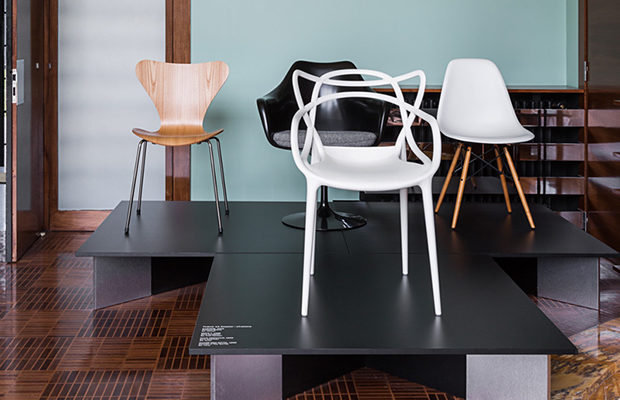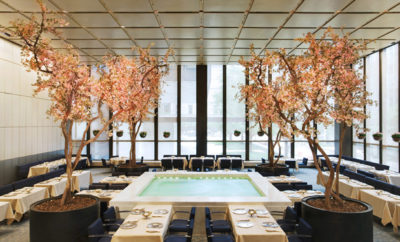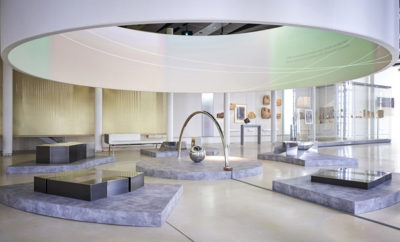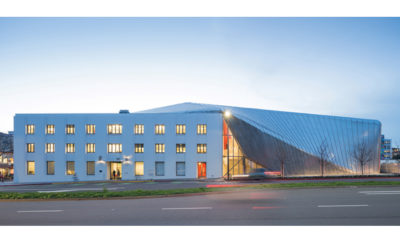 Left to right: Série 7. Arne Jacobsen 1955. Ed. Fritz Hansen; Tulip Armchair, Eero Saarinen, 1956. Ed. Knoll; Masters, Philippe Starck, 2008. Ed. Kartell; Chaise DSW Eiffel, Charles and Ray Eames, 1950. Ed. Vitraen.
Left to right: Série 7. Arne Jacobsen 1955. Ed. Fritz Hansen; Tulip Armchair, Eero Saarinen, 1956. Ed. Knoll; Masters, Philippe Starck, 2008. Ed. Kartell; Chaise DSW Eiffel, Charles and Ray Eames, 1950. Ed. Vitraen.
Exhibition
Sitting Pretty
The restored modernist Villa Cavrois offers a fine home for a new exhibition of 20th century chairs
Until its recent restoration, Robert Mallet-Steven’s Villa Cavrois was a ransacked and crumbling modernist castle, with trees sprouting inside its once ultra-sleek salons. But thanks to the advocacy of such architects as Renzo Piano and Tadao Ando, and the French government’s meticulous $25 million rehabilitation, the 1932 private villa has been given a long-awaited second chance at life. Situated in a posh little town near the capital of France’s rust belt (and just a fast, one-hour train ride from Paris), the villa has drawn over 100,000 visitors since opening its doors last summer.
Fortunately, the new destination is in good hands: France’s Centre des Monuments Nationaux (CMN)¬—which is in charge of the Arc de Triomphe, Chartres, among other heritage sites preserved for the public—will manage the estate. For the CMN, the success of the villa Cavrois will be something of a test, with one critical objective being to showcase the best in modernism today. And it is with that intention that the current exhibition of chairs, Etat de Sièges, came to fruition.
“We’ve all seen countless exhibits about the 1930’s, so at the CMN we wanted Mallet-Steven’s villa to be more than just a static museum to the ‘30s,” explains Alexandre Pouliguen, the administrative officer for CMN, on site at the villa. “The spirit in which the client, Paul Cavrois, and Mallet-Stephens conceived the villa, adopting every cutting edge modernity of the time, best lives on if contemporary modernity can be shown in such a setting, to a more diverse audience.”
Fulfilling that goal, the exhibition features 32 chairs, from the Eameses and Breuer to an early (2004) 3D “stereo-lithographic” Chaise Solid C2 by Patrick Jouin. The show is rich in zany late 1960s Italian provocations, both amusing and subversive, also revealing new technologies for plastics, and even packaging.
Curator Claude Courtecuisse (whose own chair design, from 1969, is shown “in conversation” with a Sottsass and Kuramata) assiduously avoids the word “design”—preferring the term, “industrial creation.”
“It is only around 1965 that consumer society really brings out, through numerous products, the notion of ‘design,’ when paradoxically the American company Knoll launched a ‘high end’ version of the Breuer chair [the Wassily,1925–1927] originally intended to be altruistic and affordable,” explains Courtecuisse.
Chairs are grouped under thirteen different themes, from “Form /Formless” to “Submission/Revolution.” Under “Provocation,” an all-steel 1951 Eames DKR Eiffel chair shares the stage with clunky boulders left lying on the floor—which are in fact hyperrealist polyurethane foam rocks by Piero Gilardi (1968).
Several light-bulb moments occur during the show as industrial innovations are exemplified, and womb-like amorphous creations are confronted with anxiety-provoking cantilevers that seem to defy the rules of gravity and ergonomics.
Wrapped in natural light from streamline windows overlooking the Cavrois family’s former grounds, the chairs in the show find the perfect setting in this modern mansion to showcase the ingenuity and imagination that went into their design—much like the achievements exemplified in Mallet-Stevens’s own creation of the villa.
Etat de Sièges runs until June 11th.












